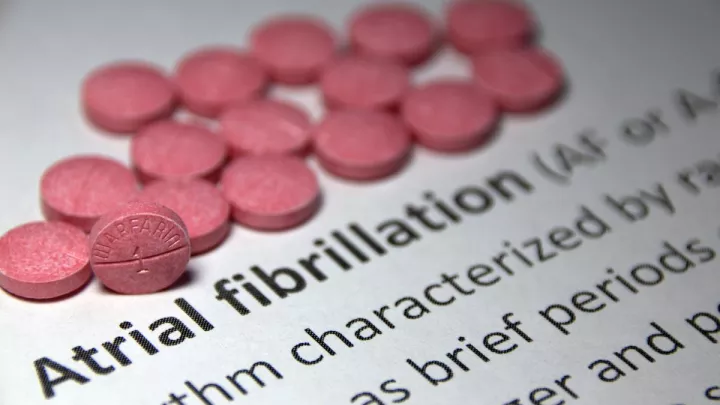Atrial fibrillation causes, symptoms and treatment options

Your heart is one of the most critical parts of your body, responsible for pumping your blood. Unfortunately, many diseases target your heart and affect its ability to send blood circulation throughout your body efficiently. One of the most common conditions that affect the heart is atrial fibrillation or AFib.
What is atrial fibrillation?
“Atrial fibrillation is a disorganized heart rhythm,” says cardiologist Shane Tsai, MD. “It’s the most commonly acquired heart rhythm disorder in this country, affecting at least 3 million adults in the U.S.”
“In addition to symptoms, AFib has a lot of potential long-term complications, including stroke and heart failure, which is why it’s an incredibly significant disease in our population,” says Dr. Tsai.
Symptoms of AFib
Some people with atrial fibrillation are minimally symptomatic, so you may not even know you have a heart rhythm disorder. This potential lack of symptoms can make diagnosing and treating AFib difficult if you aren’t aware of the issue.
“Some people can feel an irregular heartbeat or may even experience chest discomfort or shortness of breath,” says Dr. Tsai. “Some symptoms of AFib are related to another progressive disease; for example, if you develop heart failure in addition to a breathing disorder, you can get more fatigue or body swelling.”
Potential symptoms of AFib include:
- Dizziness
- Weakness
- Faintness
- Fatigue
- A fluttering or thumping in your chest
Types of atrial fibrillation
Health care providers categorize atrial fibrillation based on its duration. There are three main types of AFib, which include:
- Paroxysmal atrial fibrillation – your arrhythmia comes and goes
- Persistent – your arrhythmia is more advanced and tends to stick around for seven days or longer
- Permanent or long-standing persistent – your atrial fibrillation is constant and never returns to a normal rhythm
“In general, we think that persistent and permanent atrial fibrillation is worse than paroxysmal, but we make many treatment decisions based on symptoms and risks, not necessarily which type of AFib you have,” says Dr. Tsai.
Causes of atrial fibrillation
Common causes of atrial fibrillation include:
- Hypertension
- Coronary disease
- Heart failure
- Valvular heart problems like mitral valve disease
- Genetics – there’s an inheritable component to atrial fibrillation
- Excess alcohol intake or drug abuse
“We use a CHADS2VASc scoring system to determine your risk for stroke related to atrial fibrillation,” says Dr. Tsai. “The more points you receive in this system, the greater your risk.”
Factors that the CHADS2VASc assessment rates include:
- Congestive heart failure
- Hypertension
- Age greater than 65 or 75 years
- Diabetes
- Stroke – prior or transient ischemic attack
- Vascular disease, including coronary artery disease or heart attack
- Sex – those assigned female at birth are at greater risk
Treatments for Afib
“We divide treatment strategies for atrial fibrillation into two general categories: rate and rhythm control,” says Dr. Tsai.
“Heart rate control therapy may be more appropriate if you’re minimally symptomatic,” says Dr. Tsai. “For these people, we target a heart rate in atrial fibrillation less than 100 to 110 beats per minute with mild-to-moderate activity. If you’re more symptomatic or have heart failure, we target a stricter rate control, less than 80 beats per minute.”
Primary rate control treatments involve using medications to slow down your heart rate. “We also use many of these medications for blood pressure control, which can confuse patients,” says Dr. Tsai. “But we have a lot of patients with AFib who also have high blood pressure, so these medications give them a two-for-one effect.”
Anti-arrhythmic drugs
The second category of AFib treatment is rhythm control. “If you’re more symptomatic, we use a more aggressive rhythm control treatment,” says Dr. Tsai. There are two methods for rhythm control treatments: anti-arrhythmic drugs or catheter ablation.
There are many anti-arrhythmic drugs, the primary two being sodium and potassium channel blockers.
“These medications can be dangerous and pose a risk for sudden cardiac death,” says Dr. Tsai. “That’s why we mandate hospitalization for some of these drugs when first starting them.”
Most anti-arrhythmic medications suppress atrial fibrillation in only 1 in 3 patients. Additionally, if one anti-arrhythmic drug fails, the chances another works better are closer to 1 in 8.
“Our most powerful anti-arrhythmic medication is amiodarone, which works a little more than 50% of the time,” says Dr. Tsai. “But amiodarone has a lot of dose cumulative side effects.”
Essentially, amiodarone stores in various tissues in your body and can create scarring effects. So, over a long period, it can cause reversible and irreversible damage to different organs.
“Unfortunately, many providers use amiodarone frequently because it’s more potent and doesn’t necessarily require a hospital stay, but people often ignore these side effects,” says Dr. Tsai. “People should consider amiodarone a last-line therapy because while it works, the potential for short- and long-term side effects are more significant than many realize.”
Anyone on an anti-arrhythmic drug should receive very close monitoring of the drug and its potential side effects. That’s why in the Nebraska Medicine Anti-Arrhythmic Drug Clinic, providers work with a medical pharmacist who sees you once or twice a year to review all your medications for potential interactions. This medical pharmacist will also order appropriate lab test screening.
“Because your liver and kidneys excrete or metabolize anti-arrhythmic drugs, it’s essential to monitor and ensure your liver and kidneys are functioning properly,” says Dr. Tsai. “If they aren’t working well because of injury or any other reason, these drugs can build up to unsafe levels.”
Catheter ablation
The other treatment for rhythm control is catheter ablation. “We know that approximately 65% to 75% of triggers for atrial fibrillation – the thing that puts people into this abnormal rhythm – is a trigger that comes from the pulmonary veins, which connect the lungs and the heart,” says Dr. Tsai. “So, we focus on electrically isolating these veins during an ablation procedure.”
Currently, we isolate these veins in one of two ways: radiofrequency or cryoballoon ablation. A radio frequency ablation involves your provider using heat to put pinpoint burns around the veins to achieve pulmonary vein isolation. “Placing multiple pinpoint burns around the veins, we can create a target scar to electrically neutralize them so they can’t trigger AFib anymore,” says Dr. Tsai.
During cryoablation, your provider will inflate a balloon into your pulmonary veins and use a cryo refrigerant to freeze-burn the tissue around them. So, instead of putting multiple burns around the veins, your provider can use one balloon in each of the four pulmonary veins to freeze-burn them all at once.
“We do both of these procedures at Nebraska Medical Center,” says Dr. Tsai.
How to think about AFib
Contrary to what many people may believe, atrial fibrillation is a progressive disease. Being a progressive disease means AFib will stay the same for a while or worsen, but it never really goes away.
“Some people may wait until for symptoms to progress to get a procedure done, but that’s not how they should think about it,” says Dr. Tsai. “The procedure is much more effective earlier in the disease than later.”
“We should think of atrial fibrillation kind of like we think of cancer. The data shows that the earlier we do an ablation to get rid of AFib, the more likely we can potentially cure the disease.”







